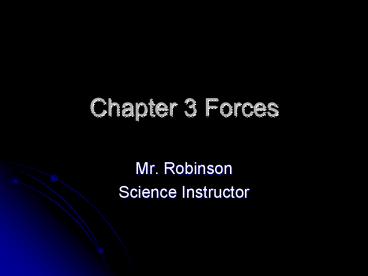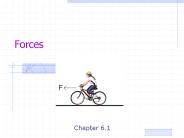Chapter 3 Forces - PowerPoint PPT Presentation
1 / 33
Title:
Chapter 3 Forces
Description:
Softball has less velocity after it leaves your ... Terminal Velocity ... When it falls with a constant speed called the terminal velocity. Section 2 Gravity ... – PowerPoint PPT presentation
Number of Views:44
Avg rating:3.0/5.0
Title: Chapter 3 Forces
1
Chapter 3 Forces
- Mr. Robinson
- Science Instructor
2
Section 1 Newtons 2nd Law
- The acceleration of an object depends on its mass
as well as the force exerted on it. - Force, mass, and acceleration
- Example Softball with mass of 0.20kg and
baseball with mass of0.14kg - Softball has less velocity after it leaves your
hand
3
Newtons 2nd Law of Motion
- Newtons 2nd law of motion describes how force,
mass, and acceleration are connected - The net force acting on an object causes the
object to accelerate in the direction of the net
force
4
Motion Equation
5
Newtons 2nd Law
- The SI units, the unit of mass is kilogram (kg),
and the unit of acceleration is meters per second
squared (m/s2) - Force has the units kg x m/s2 is called the
Newton (N)
6
Friction
- Friction is the force that opposes motion between
two surfaces that are touching each other - The amount of friction between two surfaces
depends on two factors - The kinds of surfaces
- The force pressing the surfaces together
7
What causes friction
- All surfaces have dips and bumps
- Areas where the highest bumps come in to contact
with each other - Areas where the bumps stick together are called
microwelds - Microwelds are the source of friction
8
Microwelds
9
Sticking Together
- The stronger the force pushing the two surfaces
is, the stronger these microwelds will be - More surface bumpsmore contact
- To break these microwelds and move one surface
over the other, a force must be applied
10
Static Friction
- A force that resists the effort to move something
is called friction - Static friction is the friction between two
surfaces that are not moving past each other
11
Static Friction
12
Sliding Friction
- Sliding friction is the force that opposes the
motion of two surfaces sliding past each other - Sliding friction is caused by microwelds
constantly breaking and then forming again as the
box slides along the floor
13
Rolling Friction
- The friction between a rolling object and the
surface it rolls on
14
Air Resistance
- Acts on objects on objects that fall through the
air - The force of air resistance is in the opposite
direction to the force of gravity - Air resistance affects anything that moves in
earths atmosphere - Air resistance is pushing down
15
Air resistance
16
Air Resistance
- The amount of air resistance on an object depends
on the speed, size, and shape of the object - If no air resistance is present, then a feather
and a apple will fall at the same rate
17
Terminal Velocity
- When the forces on the falling object are
balanced and the object no longer accelerates - When it falls with a constant speed called the
terminal velocity
18
Section 2 Gravity
- Anything that has mass is attracted by the force
of gravity - Law of Gravity-any two masses exert an attractive
force on each other - Attractive Force depends on two factors
- Mass of the two objects
- Distance between the objects
19
Gravity
20
Gravitational Acceleration
- The gravitational attraction of Earth causes all
falling objects to have an acceleration of
9.8m/s2 - Newtons second law, the net force, mass, and
acceleration are related according to the
following formula - F ma
- Fm X 9.8m/s2
21
Weight
- The gravitational force on an object is called
the objects weight - Gravitational Forcemass x acceleration
- WeightNewton (N)
22
Weight and Mass
- Weight and mass are not the same
- Weight is a force
- Mass is a measure of the amount of matter an
object contains - Weight and mass are related
23
Weight and Mass
24
WeightlessnessFree Fall
25
Horizontal and Vertical Motions
- Gravity exerts an unbalanced force on a
projectile, changing the direction of its path
from only moving forward to a forward and
downward force
26
(No Transcript)
27
Centripetal Force
- Centripetal Acceleration toward the center of a
curved or circular path - Centripetal means move toward the center
- For a ball to be accelerating toward the center,
an unbalances force called centripetal force
28
Centripetal Force
- When a car rounds a sharp curve on a highway,
the centripetal force is the friction between the
tires and the road surface - If road is wet or icy tires lose their grip
29
(No Transcript)
30
Projectile Motion
- Anything thats thrown or shot through the air is
called a projectile - Projectiles follow a curved path due to Earths
gravity - Projectiles have horizontal and horizontal
velocities
31
Satellites
- A satellite is anything that moves around another
body in a generally circular path called a orbit - Earth and the other planets are satellites
because they orbit the Sun - The International Space Station orbits the Earth
is called Artificial Satellite
32
(No Transcript)
33
Section 3 The 3rdLaw of Motion
- For every action there is a equal and opposite
reaction force - When a force is applied in nature, a reaction to
it occurs - Example shooting a gun and the kick back of the
gun































